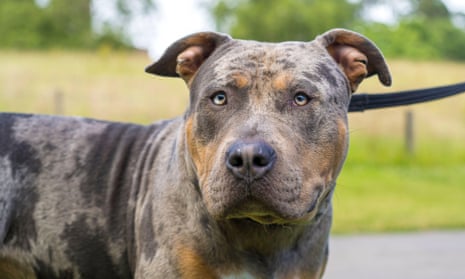When the Dangerous Dogs Act was passed in 1991, there was a lot of debate about the justice and enforceability of its terms. The pit bull was one of four banned breeds, but it was defined by its appearance and some criteria were loose, others hard to understand. “Its knee joint should be in the upper third of the dog’s rear leg, and the bones below that should appear light, fine and springy,” was one. Once you have figured out what a springy bone looks like, this could cover an awful lot of dogs. “The dog should have a good depth from the top of head to bottom of jaw and a straight box-like muzzle,” was another, which could describe the staffordshire bull terrier and wipe out the sixth most popular breed in the UK. The law never required any suspect to meet the description perfectly; it makes no mention of ears, colour, height or weight.
The upshot is that the American bully XL, all over the news after a series of horrific attacks, is basically already banned, since it’s essentially just a pit bull, only bigger. So, Suella Braverman’s demand for “urgent advice” on whether to ban the breed may come back with the news that it’s unnecessary. If not, she seems set on adding it to the list. This would mean the extermination of what is thought to be several thousand dogs, unless they qualify for an exemption.
The RSPCA has always opposed the Dangerous Dogs Act for exactly this reason: that it takes in a lot of dogs who haven’t done anything. But the “deed not breed” argument is vexed by the fact that dogs don’t observe a nursery slope of aggression, where they start with something micro and give an owner plenty of warning before they nearly kill someone. Behaviourists talk about a “ladder of aggression”, where there are multiple warning signs before a bite, but they move pretty fast up that ladder and the first incident can culminate in the worst one possible.
The debate leading up to that original legislation always felt to me like a moral panic, as defined in the 70s by Stanley Cohen – “where something or someone is identified as a threat to the values of a society” – and as such ridiculous, since it’s a fragile society that can be undone by a creature who will sit for treats. The argument that pit bulls were inherently more aggressive than other breeds was implausible, given that, breed-wise, the highest bite-per-dog is the dachshund. (Yes, obviously, an out-of-control pit bull can do a lot more damage than a dachshund, but then so can a German shepherd, or an Irish wolfhound.)
But it was never only about the dogs – it was also about the owners. When people muttered: “It’s not the dogs – it’s the owners”, it felt heavily class-coded; that these were the types of dogs kept by the wrong type of people. You didn’t meet many pit bulls on Hampstead Heath, put it that way. I was reprimanded once when walking my staffy-ridgeback cross on a manicured footpath through the Sussex countryside. When I pointed out that dogs were explicitly allowed, it being a path, the guy said: “Nice dogs. Not dogs like that.” In other words, why don’t we both push off back to inner-city London?
Sociologists in the US describe something similar but refracted through race, Julie LaBagnara contending that “middle- and upper-class ‘white dogs’… receive social allowances that dogs associated with people of colour do not”.
Like any debate that is freighted with more than it will say out loud, it takes on an absolutist timbre: “all these dogs are killing machines that must be exterminated” versus “all dogs are born good, but some people shouldn’t keep dogs”.
Into that context, the American bully XL is the worst possible arrival. There is a good chance that some are born bad, since they are incredibly expensive, yet not recognised by the Kennel Club, which has led to a lot of unregulated overbreeding. They are much too big for anyone inexperienced to control, and the consequences if they turn are so dire as to make finer adjudications about nature versus nurture tragically irrelevant. But there is a path through this that starts with a muzzle order and doesn’t go immediately to the gallows.











